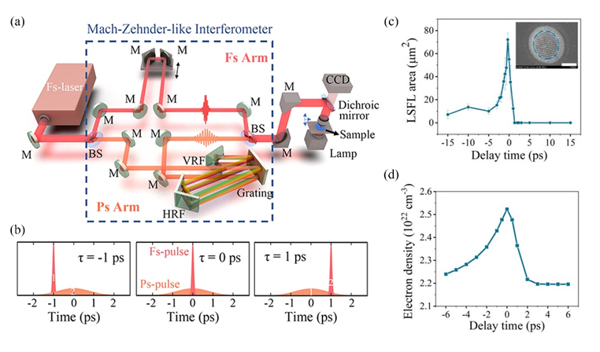How to achieve more efficient laser processing in order to meet diverse needs is a vital research topic in the field of ultrafast laser processing. In the past, people used to directly control a single beam laser parameter such as the energy, pulse number and pulse width to achieve the basic requirements. Spatiotemporal characteristics of the incident pulse can be regulated to achieve more precise functional micro/nano-structures by controlling the nonlinear ionization process at the laser focus, which may realize the rapid removal of materials. Ultrafast laser double-fs-pulse sequence has been developed as an effective processing method and is widely used for the processing of material surface and interior, where the ionization process of the material can be dynamically controlled by adjusting the delay time, energy ratio, and polarization state between two sub-pulses.
However, as the width of femtosecond pulse is extremely narrow, the interaction process between two sub-pulses in a consequence needs to be bridged by the exciton or defect induced in the material, which affects the energy deposition efficiency. In recent years, the research of double-pulse sequence using combination of long and short pulse widths has attracted much attention. This combined pulse sequence can effectively improve the processing efficiency by taking advantage of the effect of peak power of ultrashort pulse in the excitation period of long pulse. The downside of this approach is the large pulse width difference between the long and short pulses. The long pulse width far exceeds the lifetime of the electrons excited by the short pulse, resulting in a part of the pulse width in a redundant state as well as low energy deposition efficiency. In addition, the reports on long and short pulse processing mainly focused on material ablation and cutting because the long pulse used has obvious thermal effect. There are few studies on inducing the sub-wavelength periodic structure on semiconductor surface. Since the laser induced periodic structures on the material surface have demonstrated important applications in the fields of optics, biomedicine, chemistry and other fields, this study can help to understand the ultrafast ionization process and these structure formation mechanism.
The research group led by Professor Ye Dai from Shanghai University used the femtosecond (fs)+picosecond (ps) combined double-pulse sequence to control the photoionization process of ZnO surface in Chinese Optics Letters, Vol. 21, Issue 2, 2023 (W. Yin, et al., Nonlinear ionization control by temporal shaped fs+ps double-pulse sequence on ZnO).
In this work, a four-pass grating system was used to stretch short pulses of 120 fs into long pulses of 2 ps, and a combination of long and short pulse sequences was used to induce periodic structures on ZnO surfaces. The optical path design is shown in Figure (a). It is found that the morphology of the periodic structure induced by the combined pulse changes with the delay time. In particular, the case where the fs pulse arrives first, both the area of the periodic structure and the structure type show higher ionization efficiency.
Then the electron state density distribution at different delay times and positions of the combined pulse is calculated by the corresponding electron rate equation. The change of the maximum electron density value of the combined pulse with delay time is summarized in Figure (d). The trend of electron density over delay time is basically consistent with the experimental results. In the case of fs pulse arrive first, the electron excitation is higher, while ps pulse arrive first has a more rapid decline in electron density with the increase of delay.

Figure 1 (a) and (b) Schematic diagram of optical path and delay time; (c) The measured ripple area changes with the delay time; (d) Theoretical calculation results
Finally, the reason for the difference of the periodic structure is explained from the perspective of electron dynamics. For the fs+ps combined pulse with the same sub-pulse energy, the multiphoton absorption is more intensive in the case of fs pulse first arriving due to the relative higher peak power, resulting in more free electrons being excited. Very shortly, some of the excited electrons absorb the ps pulse energy more effectively through the reverse bremsstrahlung effect. This electron acceleration process will lead to avalanche ionization and further increase the electron density. When the ps pulse arrives first, the original fs pulse was temporally stretched to lower its peak power, and the excited electron density possibly becomes too small to support the growth of the periodic structure in the whole irradiated area. Fs+ps double-pulse sequence could be a new effective tool to control the nonlinear ionization process of material in the time domain, which further enriching the ultrafast laser electrons dynamics control technology.
The result demonstrates a new method of controlling electron density by ultrafast temporal shaped double-pulse sequence, which is expected to improve the fabrication efficiency of micro/nano-structures induced on the ZnO semiconductors. Different from the conventional double-fs-pulse induced ripples, the fs+ps double-pulse sequence shows more sensitive changes to the delay time. Changing the arrival order of the sub-pulse in a sequence has a significant effect on the formation efficiency of periodic structure. And selecting the appropriate pulse delay time can also achieve a higher energy deposition. At present, the group has extended this pulse combination to microfluidic channel processing, and the result has shown higher processing efficiency. The follow-up work is being prepared.


